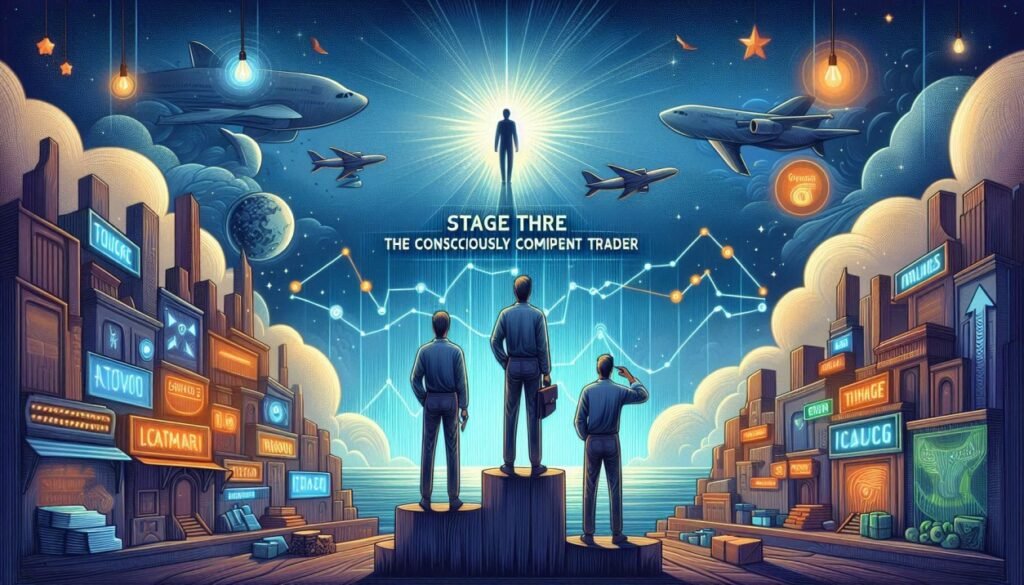Trading it’s a world that calls to many, promising financial freedom and the thrill of conquering the markets. But beneath the shiny exterior lies a challenging path that demands more than just market knowledge. It requires a deep understanding of oneself and a willingness to evolve through distinct stages. Let’s embark on this journey together, exploring the three stages that pave the way to becoming a successful trader.

The Allure of Trading
The allure of trading is undeniable. Visions of yachts, mansions, and early retirement dance in the minds of aspiring traders. The idea of controlling one’s financial destiny, making decisions that can lead to substantial profits, is a powerful motivator. The markets seem to offer endless opportunities, and the stories of those who’ve achieved incredible success fuel the dreams of countless others.
The Reality of Trading
However, the reality of trading is often a far cry from the dream. The markets are complex, unpredictable, and unforgiving. Many traders enter the arena with high hopes, only to be met with losses, frustration, and a harsh dose of reality. The emotional rollercoaster of trading can be overwhelming, leading to impulsive decisions and costly mistakes. It becomes clear that trading is not just about analyzing charts and following strategies; it’s about mastering one’s emotions and developing a disciplined mindset.
The Three Stages
Mark Douglas, a renowned trading psychologist, outlines three distinct stages that traders typically go through on their path to success. These stages are not just about acquiring knowledge; they’re about personal transformation and the development of winning attitudes. Let’s delve into each stage and uncover the lessons they hold.
Stage One: The Mechanical Stage
In this initial stage, traders are like students in a new school. They’re eager to learn the rules, understand the terminology, and grasp the basic concepts of trading. They immerse themselves in books, courses, and webinars, absorbing information like sponges. They learn about technical analysis, fundamental analysis, risk management, and trading strategies.

Learning the Rules
Just as a driver’s education student learns the rules of the road, a trader in the mechanical stage learns the rules of the market. They study chart patterns, indicators, and market trends. They experiment with different trading strategies, trying to find what works best for them. This stage is crucial for building a foundation of knowledge, but it’s just the beginning.
Developing a Trading Plan
A trading plan is like a roadmap for a trader. It outlines their goals, risk tolerance, entry and exit strategies, and money management rules. In the mechanical stage, traders meticulously craft their trading plans, hoping to create a foolproof system that will lead to consistent profits. They backtest their strategies, analyze historical data, and fine-tune their approach.
The Importance of Discipline
Discipline is the cornerstone of successful trading. In the mechanical stage, traders learn the importance of sticking to their trading plans, even when emotions run high. They realize that impulsive decisions and deviating from their strategies can lead to losses. They practice patience, waiting for the right setups and avoiding the temptation to chase the market.
Stage Two: Subconsciously Incompetent
As traders progress to the second stage, they begin to realize that trading is not as simple as they initially thought. They encounter losses, experience setbacks, and face the harsh realities of the market. They become aware of their own flaws, emotional biases, and the challenges of maintaining discipline.

Recognizing Your Flaws
In this stage, traders start to recognize their own weaknesses. They may realize that they’re prone to fear, greed, or impatience. They may discover that they have difficulty cutting losses or letting profits run. This self-awareness is a crucial step in the journey, as it allows traders to address their shortcomings and develop strategies to overcome them.
The Role of Emotions
Emotions play a significant role in trading. Fear can lead to hesitation and missed opportunities, while greed can lead to overtrading and taking on excessive risk. In the subconsciously incompetent stage, traders become more aware of how their emotions influence their decisions. They learn to identify their emotional triggers and develop techniques to manage their emotional responses.
Embracing Mistakes
Mistakes are inevitable in trading. In this stage, traders learn to embrace their mistakes as valuable learning experiences. They analyze their losing trades, identify the factors that contributed to the losses, and use this knowledge to refine their strategies. They understand that mistakes are not failures but stepping stones on the path to success.
Stage Three: The Consciously Competent Trader
In the final stage, traders reach a level of conscious competence. They’ve refined their skills, developed a disciplined approach, and learned to manage their emotions effectively. They’re adaptable, able to adjust their strategies to changing market conditions. They understand that trading is a continuous learning process and that there’s always room for improvement.

Refining Your Skills
In this stage, traders continue to refine their skills. They may delve deeper into technical analysis, explore new trading strategies, or expand their knowledge of market fundamentals. They constantly seek to improve their understanding of the markets and their own trading behavior. They may also seek mentorship from experienced traders or join trading communities to learn from others.
Adapting to the Market
The markets are constantly changing, and successful traders must be able to adapt. In the consciously competent stage, traders develop the flexibility to adjust their strategies as market conditions evolve. They understand that what worked in the past may not work in the present, and they’re willing to change their approach when necessary. They also recognize that market conditions can change rapidly, and they’re prepared to react quickly to new developments.
The Importance of Continuous Learning
Trading is a journey, not a destination. In the final stage, traders embrace the importance of continuous learning. They understand that the markets are constantly evolving, and they must evolve with them. They stay up-to-date on market news, economic developments, and new trading techniques. They also continue to analyze their own trading performance, seeking to identify areas where they can improve.
Conclusion
The journey to becoming a successful trader is not an easy one. It requires dedication, discipline, and a willingness to learn and grow. The three stages outlined by Mark Douglas provide a roadmap for this journey, highlighting the importance of knowledge, self-awareness, emotional control, and adaptability. By understanding and embracing these stages, traders can increase their chances of achieving their trading goals and finding fulfillment in the exciting world of trading.

The Journey of a Trader
Remember, trading is not just about making money; it’s about personal growth and self-discovery. It’s about developing the mental fortitude to face challenges, overcome obstacles, and achieve success. It’s about becoming the best version of yourself as a trader and as an individual. So, embrace the journey, learn from your experiences, and never stop striving for excellence. The rewards are not just financial; they’re also personal and profound.


